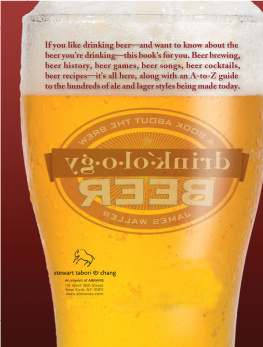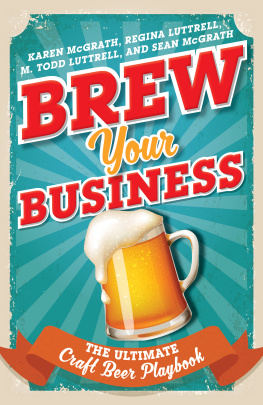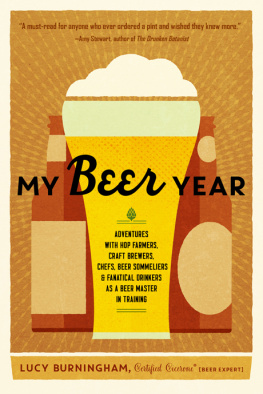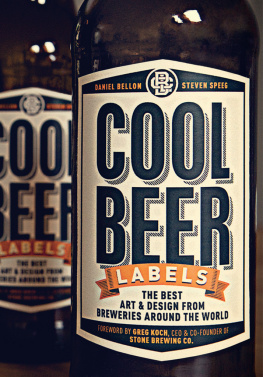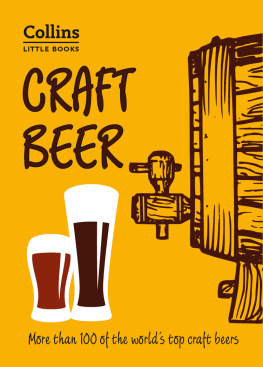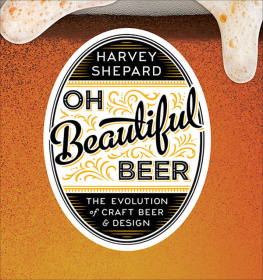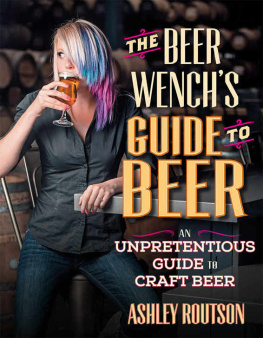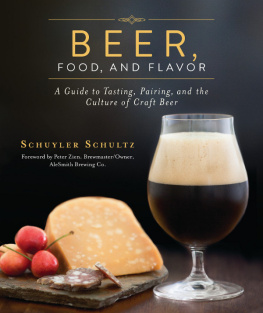

Oh Beautiful Beer
Copyright 2015 by Harvey Shepard
All rights reserved
The Countryman Press
www.countrymanpress.com
A division of W. W. Norton & Company
500 Fifth Avenue, New York, NY 10110
www.wwnorton.com
For information about permission to
reproduce selections from this book,
write to Permissions, W. W. Norton & Company, Inc.,
500 Fifth Avenue, New York, NY 10110
For information about special discounts for bulk
purchases, please contact W. W. Norton Special Sales
at or 800-233-4830
978-1-58157-315-2 (hardcover)
978-1-58157-583-5 (e-book)
To Leah, for her appreciation of good beer, clean design, and me

Contents

Beer has been around for thousands of years, so it should come as no surprise that we have found many different ways to deliver it to our mouths. The early evolution of beer drinking vessels is a long list that includes skulls, cattle horns, steins, mugs, tankards, and cups. Stoneware, ceramics, pewter, wood, leather, bronze, silver, gold, porcelain, and china have all been used extensively as the base materials.
For a long time, bars and breweries were undoubtedly the favorite place to enjoy a beer. This trend began to turn after Prohibition, as take-home packaging started to hit its stride and consumers began drinking at home more commonly.

Historically, beer labels have not always matched the contents of the bottles on which they appeared. It was once common practice for lesser brewers to sell forgeries of popular beers and brews marketed as imports were often actually produced locally. These techniques were especially problematic for popular brewers Guinness, William Younger, and Bass. Low quality imposters sold under their names were diminishing their brands.
On January 1, 1876, a solution for these breweries arrived in the form of the United Kingdoms Trade Marks Registration Act. Wanting to be the first to take advantage of this new legislation, Bass sent an employee to wait outside the registrars office overnight. For their efforts, Basss Red Triangle became the worlds first registered trademark. Bass also received trademark number two, the Red Diamond, for their strong ale.

Design credits: Bauhaus Brew Labs by Helms Workshop, Bottle Logic by Emrich Office, Browns Brewing by id29, Daredevil Brewing by Cultivator Advertising & Design, Fair State by Little & Company, Fullsteam by Helms Workshop, Great Divide by Cultivator Advertising & Design, Great Raft by Derouen & Co., Partizan Brewing by Alec Doherty, Sixpoint Brewery by Lefty Lexington
St. Peters Brewery
BUNGAY, ENGLAND DESIGN BY NELSON ASSOCIATES
People began experimenting with beer in glass bottles as far back as the 16th century. Like other alcoholic beverages, it was put into hand-blown glass bottles affixed with a cork. The high-pressured nature of beer caused this situation to be less than ideal. It was accidentally discovered that beer left in a bottle underwent a secondary fermentation, causing an explosive increase in carbonation. Thicker bottles were called into duty and corks were reinforced with twine and wire. Beer in glass bottles would not become commercially available for another hundred years.
Advances in manufacturing, as well England lifting the glass tax in 1845, paved the way for beer bottles to thrive in the market. The discovery of pasteurization in 1876 was a major victory for beer bottles, as breweries now had a way to keep bottled beer fresh for much longer. This discovery coincided with the growth of the American rail system, together sparking a boom in distribution.
While time and technology has left these early bottles behind, St. Peters Brewery sought to revive them. Despite opening in England in 1997, they found their inspiration in 18th century America.
These distinctive oval, high-shouldered bottles are a replica of a gin bottle found outside of Philadelphia. This bottle dated back to 1770 and was produced for local innkeeper Thomas Gerrard.
While so many breweries stand out for their iconic artwork, Nelson Associates focused the brand around the bottle itself. They created a sophisticated and subtle labeling approach. Free of paper, the bottle is embossed with the brewerys logo and details about the beer are spelled out in gold foil lettering, which is applied directly to the bottle.




Rogue
NEWPORT, OREGON, USA DESIGN BY PENNY MUIRE
Beginning in the mid-19th century, ceramic was a popular choice for beer bottles, especially porters. These vessels were strong, heavy, and expensive to produce. Thus, breweries took extra measures to encourage their return, embossing their name and city across the bottle. If the company also produced soft drinks, words like Beer Co. would be omitted. This style mostly disappeared with the 1800s.
Rogues XS series pays homage to these relics, with a range of strong ales packaged in ceramic swing-top 750ml bottles. These Rogue bottles are rather popular with homebrewers. As bootleggers in the 1800s quickly realized, these are ideal for refilling with a libation of your own.
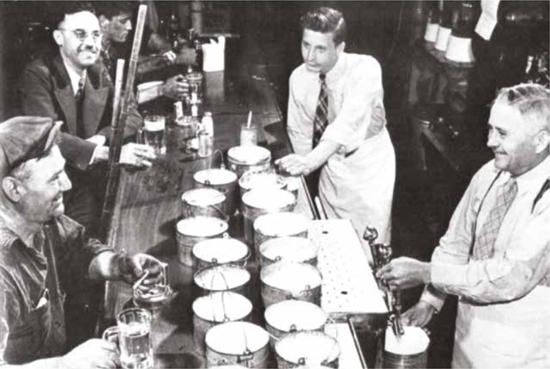
Up until bottles became popular (and practical) in the early 1900s, the only way to bring beer home was by the bucketful. Fresh beer was filled at the local bar and carried home in growlers. These containers were typically two-quart galvanized pails, but could also be pitchers, jars, jugs, or other pieces of pottery. A trip to the bar to refill these buckets was commonly referred to as rushing the growler and was performed by children as well as adults.
The history behind the word growler has led to some debate. One belief is that while the beer was in transit, the carbon dioxide growled as it escaped underneath the lid of the bucket. Others point to the growling between patrons and bartenders over what constituted a full bucket as the source of the term. Regardless of where the name comes from, that little bucket was just one early step toward the beer packaging we are now accustomed to taking home.
Next page

